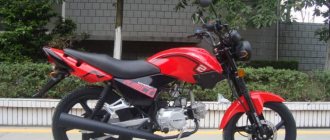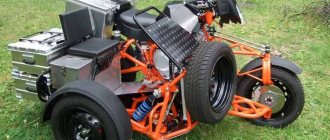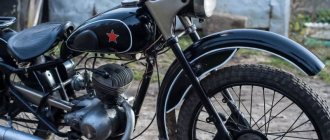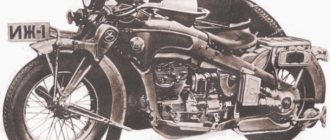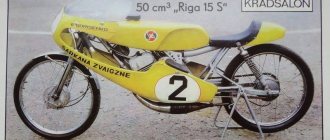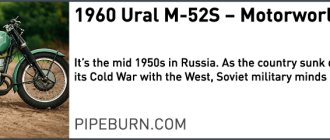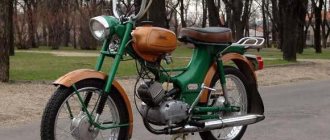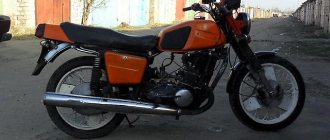Author: Kot shashlik
26 May 2015 09:05
Tags: USSR auto moto motorcycle Soviet motorcycles
43047
14
Motorcycles played a very important role for citizens of the USSR. Often, they were the only opportunity to gain freedom of movement. They rode them to work, on vacation to the seaside, picked up children from the maternity hospital, and took girls for rides in villages.
0
See all photos in the gallery
Modern bikers have switched to foreign-made sportbikes or choppers and are completely unaware of the history of domestic motorcycles. We decided that it was time to stop for a couple of minutes and remember the 10 most popular, most beloved and most popular motorcycles from the distant USSR.
IZ Planet Sport. The fastest and most technologically advanced.
0
In 1973, the Izhevsk Motorcycle Plant surprised the whole country by showing the first Soviet motorcycle with a sports bent, the Planet Sport. Unlike all earlier motorcycles, which were created in the image of German models, Planet Sport clearly tried to be similar to Japanese motorcycles of the 60s and 70s. Due to the high quality of workmanship, IZH Planet Sport was actively sold in export markets, for example, in the UK, the Netherlands and Finland. Soviet bikers accelerated on them up to 140 km/h, which was an incredible speed in those days.
×
Sunrise. The most rustic.
0
Voskhod motorcycles began to be produced in the city of Kovrov, Vladimir region, in 1957. These were very unpretentious single-cylinder motorcycles (173.7 cm3 engine). The Dyagterev plant constantly improved this model, releasing onto the market after the Voskhod its modernized versions, Voskhod-2, Voskhod-3, Voskhod-3M. The latest Voskhod motorcycle was the 3M-01 model with a 15 hp engine. Because of their reliability, Voskhod motorcycles became real workers in thousands of Soviet villages. Even now you can easily find a Voskhod motorcycle in good condition there.
In 1958, the Kharkov bicycle factory began producing the B-901 bicycle specifically for the D-4 engine.
Compared to a regular road machine, this bike had a shock absorber in the front fork and larger tires. Apparently, the B-901 can be considered the first Soviet mass-produced motorbike. Then the production of motorbikes was transferred to the Lvov Metal Plant (since 1960, Lviv Motorcycle Plant - LMZ). In the same year, the plant began producing B-902 motorbikes, which differed from the B-901 mainly in the frame design.
In 1962, the plant’s design bureau created the MV-042 “Lvovyanka” motorbike. It was a fundamentally new model with a special load-bearing all-stamped frame, telescopic front fork and even spring-loaded rear suspension.
In the first batches of the Lvovyanka, the engine was still the same - D-4. In the process of subsequent modernization of the moped, instead of a rear fork with a central spring, they began to install double shock absorbers in aluminum casings. And, most importantly, the D-4 was replaced by a new engine - the D-5, with the compression ratio increased to 6 units. Engine power increased to 1.2 hp. at 4500 rpm, fuel consumption remained at 1.5 l/100km.
The high thermal stress of the D-5 forced the designers to use a new cylinder with developed ribs and a removable head.
The “Lvovyanka” was replaced by the light moped “MV-044”, characterized by a developed hood and angular shapes.
In 1969, they began to produce a new model - “MP-045” with a reinforced frame and a larger gas tank.
The last of the light mopeds produced by the Lviv Motorcycle Plant is “MP-047” “Tisa”. After this model, the plant completely switched to the production of heavy mopeds - “Verkhovyna”, and subsequently “Karpaty”.
It should be noted that rear shock absorbers were installed on all light mopeds of the Lvov plant. Light mopeds from other Soviet factories, as well as most foreign light mopeds of those years, did not have such “luxury”.
Almost simultaneously with the plant in Lvov, the production of light mopeds was launched at the Riga motorcycle plant “Sarkana Zvaigzne” (“Red Star”) and at the Penza Bicycle Plant named after M.V. Frunze.
The running gear of the first light moped, the production of which began in Riga in 1959, was the Riga-16 men's bicycle manufactured here.
The familiar D-4 engine was installed on the bike. (A. Popov, Cooled Star, “Moto”, No. 1, 2012, p. 88). The resulting design was very reminiscent of the B-901 motorbike from the Kharkov bicycle factory.
M-62. Choice of police.
0
The Soviet police, fair and incorruptible, in the 50s-60s mostly traveled on motorcycles with sidecars. The M-62, produced by the Irbit Motorcycle Plant, was the most popular choice of servants of the law. Its four-stroke engine produced 28 hp. An interesting fact is that ordinary citizens of the USSR were not allowed to operate Urals without a sidecar at that time. Still, these motorcycles were quite difficult to control. But the police used motorcycles without sidecars, which looked very cool in the eyes of Soviet boys. How can you not want to become a policeman!
"PMZ-A-750"
In 1931, the development of medium and heavy motorcycles for the army and the national economy began. The first was the heavy motorcycle “NATI-A-750”. This car was a mixture of traditions: an American-type power unit was built into the chassis, made in the image of a BMW. “PMZ-A-750” was used not only in the army, NKVD units, but also in the civil service. The design of the motorcycle turned out to be durable, but very capricious. As a joke, the letters PMZ were deciphered as “Try to turn me on.”
Tula-200. For hunters and fishermen.
0
The Soviet motorcycle industry did not produce ATVs (some small-scale models, however, were still produced, read below), but for the needs of hunters and fishermen, a very unusual Tula-200 motorcycle with wide off-road wheels was produced. The mass distribution of such motorcycles occurred in 1986-1988. The engine was taken from the Tulitsa motor scooter, increasing its power to 13 hp. This made it possible to accelerate at 200k to 90 km/h. 10-12 thousand of these bikes were produced per year, the last of which rolled off the plant’s assembly line in 1996. By the way, they even produced a trike based on the Tula-200!
"Minsk M1A". First Belarusian
To this day, the “Minskachi” remains the most “popular” motorcycle in Belarus. They run along the roads of the entire former Union, and not only. But most of them, of course, are in their homeland.
Minsk motorcycles passed their half-century anniversary a long time ago (the first models already fully deserve the name “vintage”), and very soon, on July 12, they will celebrate their 61st birthday. The first Belarusian “bike” was the Minsk M1A, which had many “relatives” not only in the USSR, but also abroad. The “ancestor” of the motorcycle was developed in 1939 by the Germans. The DKW RT125 turned out to be so successful that analogues of this motorcycle were produced under different names in 7 countries around the world, including the USA, England and Japan. By the way, one of the old “Minsk racers” was tested in harsh conditions by one of the hosts of the famous British show Top Gear, Richard Hammond. He drove it from south to north almost all of Vietnam. CV of the charismatic “car maniac”: “This is the AK-47 among motorcycles - reliable, simple, easy to repair. It was made specifically for those countries where there are no roads.”
IZH-49. The most durable.
0
Reliable, durable, beautiful. The sound of its engine for the Soviet ear was akin to the sound of a Harley-Davidson engine for Americans. Their production began in 1951. At its core, it was an improved design of the German motorcycle DKW NZ 350. IZH-49 won great love among the population and was used in all corners of the vast Soviet Union. On its basis, versions with a sidecar were produced, as well as sports motorcycles for cross-country and road racing. Now IZH-49 is a collector's item. Prices for them start from 100 thousand rubles.
M-1A "Moscow". The first post-war.
0
After the war, the Moscow Bicycle Plant began producing a copy of the German DKW RT125 motorcycle with a 125 cc engine. M-1A "Moscow" became the first post-war motorcycle of the USSR. It was a simple and lightweight motorcycle that did not require much metal or rubber to produce. Such motorcycles were used in huge quantities to train motorcyclists in DOSAAF schools. Perhaps your grandfather studied just like this. In 1951, production was transferred to Minsk to a bicycle factory built there. An almost identical model was produced in Kovrov under the designation K-125.
"L-300. "Red October"
This motorcycle was copied from the German DKW Luxus 300 in 1930. In the same year, the first models rolled off the assembly line. Although production ended in 1938, the history of the motorcycle did not stop there. The basis of the two-wheeled vehicle was taken for the design and production of the IZH-8 (which, by the way, is even depicted on silver coins of New Zealand).
Jawa 360. The most beautiful.
1
In the 70s, every third motorcyclist rode in Java. In total, more than 1 million Jawa motorcycles of various models were delivered to the USSR, but the 360 was the most beautiful of all. Nowadays, cherry-colored motorcycles with chrome-plated gas tanks are called “Old Lady.” Particularly valuable are specimens with a side stroller made of fiberglass. Versions were produced with a 1-cylinder engine (250/260) or with a 2-cylinder engine (350/360). By the way, Java often appeared in various films. For example, it is on the Jawa 360 that Gesha Kozodoev takes Semyon Semenovich Gorbunkov fishing on the White Rock in the film The Diamond Arm.
Pannonia
Rarity lovers are still chasing a well-preserved model of this motorcycle. The lines of the Pannonia were so unusual for its time that the motorcycle instantly became a cult classic. The most popular model was the Pannonia 250 TLF: an 18-liter tank, 350 cc engine and sidecar made it ideal for long journeys.
Jawa 350/638. Motorcycle of the roaring 90s.
0
The last of the Jawas sold in the USSR, Jawa 350 638, also became a “people's” motorcycle. Having managed to come out just before perestroika, in 1984, this model often appeared in harsh films of the late 1980s and early 1990s. Thus, “Java 350 638” can be seen in the drama “Accident - the Cop’s Daughter” and the action film “Rats, or the Night Mafia.” There is even a song “Java” dedicated to the motorcycle by the popular group “Sector Gaza” in those years.
"Chezet"
The history of the legendary “Cezet” goes back to pre-war times, when the Czechoslovak arms factory Ceska Zbrojovka (CZ) decided to start producing motorcycles. In 1936, the plant produced prototypes of the Cheset, on the basis of which motorcycles with engines of 250 and 350 cc were later developed.
In 1960, CZ launched the Cheset motorcycles into mass production. In the USSR, CZ experienced unprecedented success. Along with the Java, this motorcycle was a success among rockers, and the black Cheset became the dream of an entire generation.
The famous cross-country Cezet was born in 1962. The motorcycle was equipped with a 250 cc single-cylinder two-stroke engine. Cheset's finest hour lasted until the end of the 60s. Racers from the USSR, Belgium and the GDR competed on it and won championships.
Vyatka VP-150. Italian elegance.
0
The last one in our review is not a motorcycle at all, but a scooter. The Vyatka VP-150, the prototype of which was the Italian Vespa scooter, is rightfully considered the most elegant two-wheeled vehicle in the USSR. It was a quiet and very comfortable scooter that even women could drive with ease. At the Vyatka base they made a whole range of three-wheeled scooters with various bodies, which were actively used in urban cargo transportation.
BONUS! 11. Riga-13. The first moped of Soviet boys.
0
Riga began producing mopeds back in 1958. Many boys dreamed that their parents would give them a moped for their birthday. This is what they did, so mopeds, and especially Riga-13, became the first vehicle for many. Riga-13 began to be produced in 1983. Equipped with a 1.3 hp engine, it accelerated to only 40 km/h. To start from a standstill and move uphill, the “biker” was recommended to help the engine by rotating the pedals. Riga-13 was produced until 1998, becoming the most popular model. A truck for everyone.
0
Based on the Tula scooters, the Tula Machine-Building Plant produced a huge number of three-wheeled cargo scooters called Ant. This was a breakthrough for the Soviet Union, because the sale of vans and station wagons to USSR citizens was prohibited. So such scooters were almost the only opportunity to transport small quantities of cargo. TMZ has produced a huge number of such scooters. They were equipped with flatbed platforms, dump bodies, vans and even tanks. They are still popular today.
ZID-175 4ShP. The first Soviet ATV.
Surprisingly, in our country, despite the complete absence of roads in some places, ATVs have never been mass produced. Almost the only more or less serial copy was the ZID-175 4ShP, produced at the Dyagterev Plant.
The design was not very successful: weak engine, complex transmission elements. This is probably why such ATVs are not widely used.
source: https://pravme.ru/admin/2015-06-15-16-legendarnyh-motociklov-sssr.html
